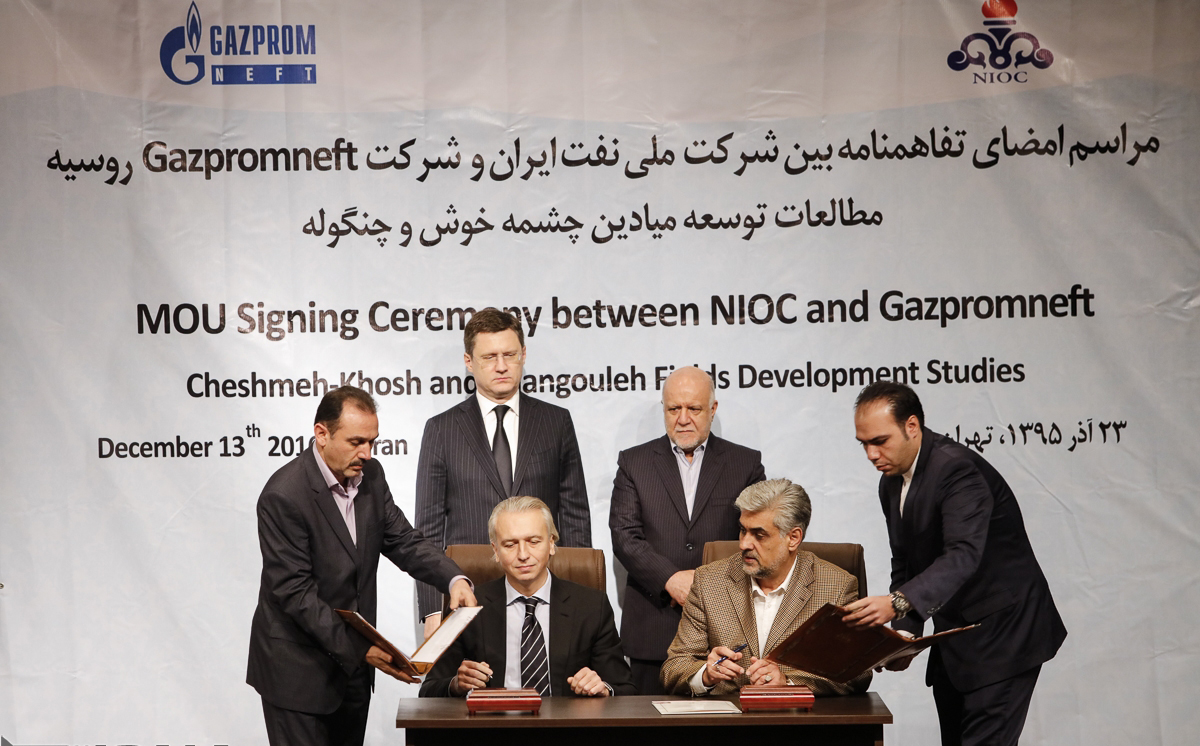Russia's Gazprom Neft PJSC signed a memorandum of understanding with the National Iranian Oil Company on Tuesday to study two oilfields in the western regions near the border with Iraq.
The agreement was signed by Salbali Karimi, the chief executive of Iran Central Oil Fields Company and Alexander Dyukov, chairman of the board and CEO of Gazprom Neft in Tehran on Tuesday. Oil Minister Bijan Namdar Zanganeh and Russian Energy Minister Alexander Novak were present at the signing ceremony, Shana reported.
Gazprom Neft, the oil arm of gas giant Gazprom, will conduct surveys on Cheshmeh Khosh and Changuleh fields in Ilam Province west of Iran, Shana reported.
Changuleh oilfield is estimated to hold more than 4 billion barrels of heavy crude in place. Iran hopes to start production from the oilfield at a rate of 15,000 barrels per day and boost output to 65,000 bpd under a five-year development plan.
Iran is also reportedly drawing around 18,000 barrels of oil and 3 million cubic meters of natural gas a day from Cheshmeh Khosh field which was commissioned over 40 years ago.
Zanganeh pointed to Iran's increasing cooperation with Russian energy companies and said, "Developing oilfields and boosting the rate of recovery are the focus of talks with Russia."
Alexander Medvedev, CEO of Gazprom said on Tuesday that his company is ready to operate in Iran's energy market alongside European majors.
"We are ready to work with other companies such as Shell and Total. Gazprom can also expand cooperation with National Iranian Gas Company."
The agreement with Gazprom Neft extended the number of Iranian oilfields to be studied by Russian companies to seven.
According to Zanganeh, Iran has signed an agreement with Russia's No. 2 oil producer Lukoil to study Ab-Teymour and Mansouri oilfields.
State-owned oil company Zarubezhneft signed a deal in July to study the potential of Aban and West Paydar in Ilam. Integrated oil and gas company Tatneft is also poised to study Dehloran oilfield in western Iran.
Amirhossein Zamaninia, deputy oil minister said on Monday that Tehran will soon sign more oil and gas study agreements with Russian firms. He did not elaborate.
------- Deals With International Firms
Tehran has had a busy few weeks signing oil and gas field development agreements with foreign companies following a breakthrough deal with Total and China National Petroleum Corporation last month to develop Phase 11 of the giant South Pars Gas Field in an agreement valued $4.8 billion.
Royal Dutch Shell inked an initial agreement last week with Iran's Petroleum Engineering and Development Company (PEDEC) to study the giant South Azadegan and Yadavaran oilfields and a gas field in Kish Island in the Persian Gulf.
Earlier this month, PTT Exploration and Production Public Company Limited (PTTEP), Thailand's state oil company, signed an MoU to study Changuleh, Belal and Dalpari oilfields.
In late November, Pergas Consortium, a group of 11 international oil and gas companies, signed a preliminary agreement to study two oilfields in Khuzestan.
Malaysia's oil giant Pertamina has also signed a nondisclosure agreement to study Ab-Teymour and Mansouri fields. Norwegian and Austrian companies have equally voiced their interest in extending oil and gas cooperation.
------- Oil Sale to Russia
Moscow has agreed to take in 100,000 barrels of crude oil per day from Iran, according to Zanganeh.
"Half of the revenue from oil export to Russia will be remunerated via the import of (Russian) technical and engineering services and the rest in cash," Zanganeh told reporters on the sidelines of the signing ceremony.
The move to sell crude to the world's top oil producer is seen as an effort to ease the import of much-need services by Iran to revitalize its cash-strapped industrial and energy sectors.
Zanganeh also expressed optimism that global oil prices will hold steady above the $50-per-barrel mark following a deal stuck between OPEC and some of the non-OPEC producers on Saturday to cut supplies by nearly 1.8 million barrels a day through the first half of 2017.
"The oil market is unpredictable, but prices look set to steady at around $50 and $55 a barrel."
-------Daunting Task
In a separate development on Monday, Zanganeh said Iran is pushing to raise $130 billion in foreign investments to develop its petroleum industry and boost crude production in the long haul.
"Iran’s oil output is currently less than 40% that of Saudi Arabia," Zanganeh told a meeting of Khatam al-Anbiya Construction Headquarters executives, adding that Iran faces a daunting task to close the gap.
Saudi Arabia boosted its oil production to a new record high in November. The kingdom told the Organization of Petroleum Exporting Countries it pumped 10.72 million barrels per day of crude last month, an increase from 10.625 million bpd in October.
Iran currently produces close to 4 million bpd of crude, almost the same as its pre-sanctions peak record.
“The important thing is to draw more crude from operational fields. Raising the rate of recovery by 1% will translate into 8 more billion barrels and some $400 billion in new revenues.”
Zanganeh stressed that Iran currently has 12 active oil reservoirs, some of which have substantially declined after more than 80 years in production.
Extraction from Azadegan and Yadavaran oilfields, two joint fields with Iraq, is a meager 6-7%, the minister was quoted as saying.


